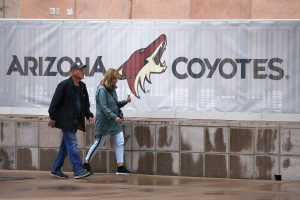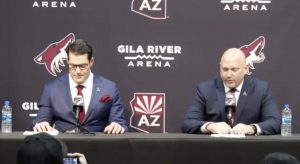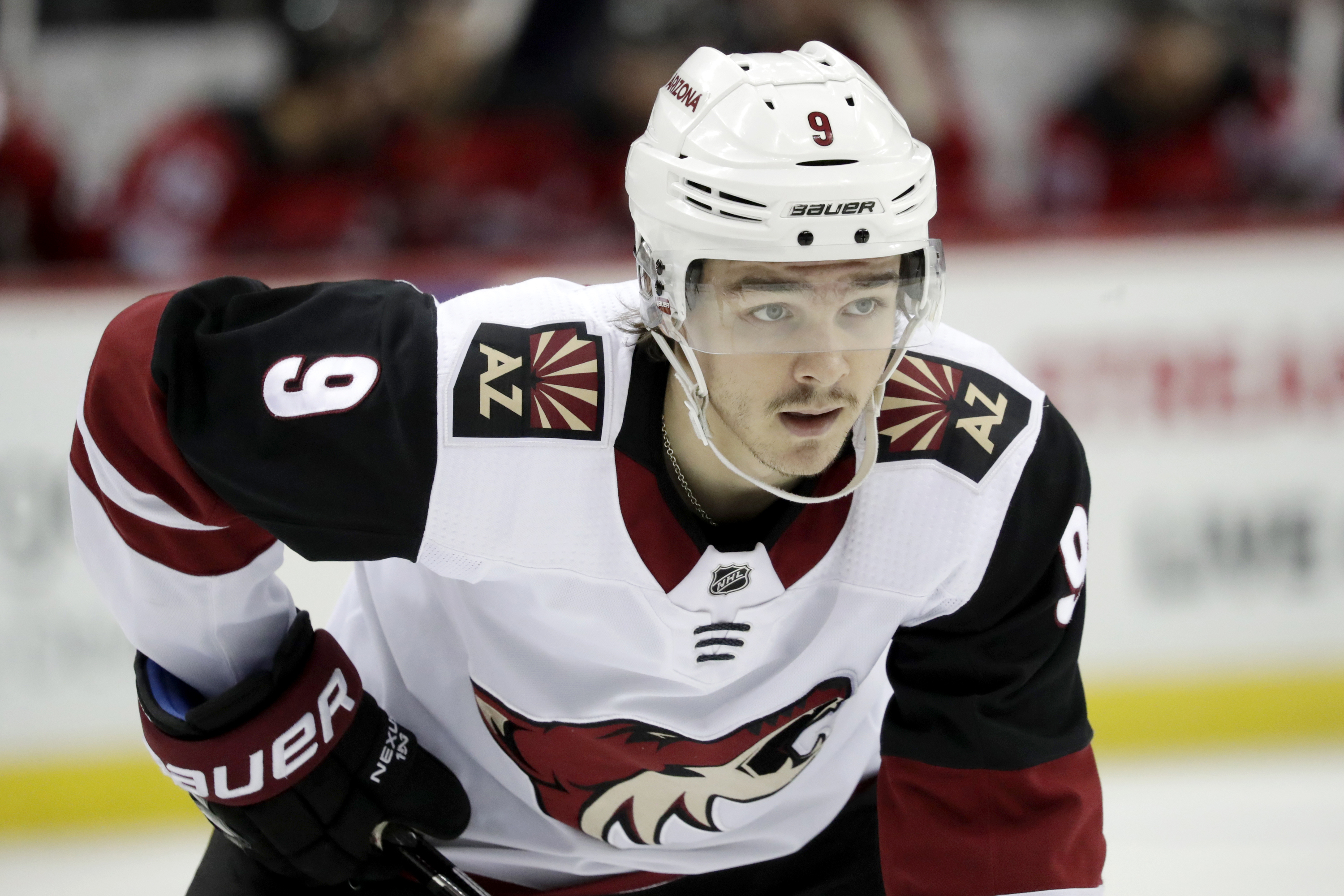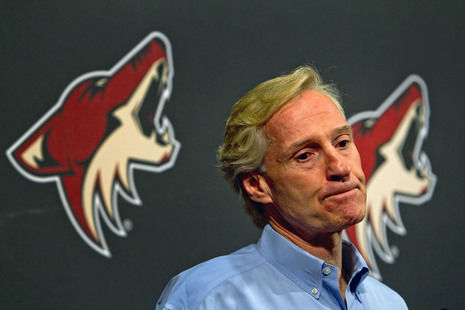The Arizona Coyotes will play their first game of the 2021-22 season Thursday night against the Columbus Blue Jackets, following an offseason that included several blockbuster trades, the hiring of a new coach, a move to a new division, and endless speculation about the team’s arena situation.
Expectations for the team on the ice, as well as the future of the organization at large, remain unclear, but the Coyotes seem determined to do everything they can to avoid the perennial mediocrity that they endured over the past three seasons, even if that means hitting rock bottom. The team’s decision to once again adopt its beloved Kachina logo brought it some good publicity, but Arizona has several questions to answer if it hopes to continue making positive headlines. Here are the biggest ones:
The Arena

It just wouldn’t make sense to start anywhere else. Ever since Aug. 19, when the city of Glendale announced it would opt out of its leasing agreement with the Coyotes at season’s end, hockey fans in the Valley have been desperate for any good news regarding a long-term home for the team in the Phoenix area. The Coyotes seem to be doing everything they can to find a solution, but the situation is nowhere close to being resolved at the time of this writing. The club submitted a bid for a 46-acre plot of land next to the Salt River in Tempe, which is under review by the city and likely will be for the next few months.
Even if Tempe approves the proposal, which would cost up to 1.7 billion dollars according to some estimates, it would only solve the long-term part of the equation. The new arena wouldn’t be ready until 2024 at very earliest, and the Coyotes would need to find a temporary home in the meantime.
Coyotes President and CEO Xavier Gutierrez was asked about the arena conundrum at a hockey clinic in Peoria on Oct. 13, and gave little in the way of new information. Gutierrez said that the team was “exploring interim options,” but did not mention any other facilities by name. A definitive answer to the team’s arena questions likely won’t reveal itself until the season is already well underway, and the guessing games are likely to continue until it does.
The Goaltending
OFFICIAL: We've signed goaltender Carter Hutton to a one-year contract.
Welcome to the desert, Carter! 🏜️https://t.co/8V9YereOTE
— Arizona Coyotes (@ArizonaCoyotes) July 28, 2021
Now that that’s over with, we can move into the issues concerning the team’s on-ice performance, and none are more pressing than the precarious goaltending situation that currently stares the Coyotes in the face. Arizona purged its entire goaltending committee from last season, trading Adin Hill and Darcy Kuemper to Western Conference rivals and letting Antti Raanta leave as a free agent.
35 year-old Carter Hutton will begin the season as the Coyotes’ starter after signing on a one-year deal for the veteran minimum of $750,000. Hutton spent the previous three seasons with the bottom-dwelling Buffalo Sabres, where he battled injuries and consistently played behind one of the worst defenses in the league. He will get more help in Arizona, but his age, limited starting experience and injury history make him anything but a sure thing. Nevertheless, he is only four years removed from posting the best save percentage in the NHL among qualified goaltenders, and it is remotely possible he could recapture the level of play that earned him his big-money deal with the Sabres.
Hutton’s backup will be none other than Karel Vejmelka, a 25-year old rookie fresh off the boat from the Czech Republic. Vejmelka entered training camp as a long shot, but impressed enough to usurp the backup job from coveted prospect Ivan Prosvetov and recently-acquired Josef Korenar. Vejmelka has spent his entire career up to this point in his native country, and there is no telling how well he might fare in the NHL. However, Colorado’s Pavel Francouz and Nashville’s David Rittich have proven that previously unknown Czech goalies can carve out solid NHL careers, and it is possible Vejmelka could be next.
The New Coach

After four years of middling results, nobody could fault the Coyotes for deciding to move on from Rick Tocchet. Annual late-season tumbles out of playoff position, coupled with the team’s yawn-inducing style of play, ended up spelling the end of Tocchet’s tenure in the desert, and he has since moved on to become a studio analyst for TNT’s hockey coverage team. In his stead, the Coyotes hired longtime junior hockey coach André Tourigny, who has pledged to inject some much-needed pace into the team’s play. Tourigny will have to work with a roster full of newcomers, and getting everyone on the same page could take time, but his system should at very least make Coyotes games more entertaining than in the past.
Competing In The Central
As if the Coyotes’ persistent lack of high-end skill weren’t enough of an obstacle to their playoff chances, the team now gets to play in what is arguably hockey’s toughest division. Thanks to the Seattle Kraken’s entrance into the league, Arizona was forced to relocate to the Central Division, where it will enjoy regular meetings with the Presidents’ Trophy-winning Colorado Avalanche, 2020 Western Conference champion Dallas Stars and upstart Minnesota Wild. Colorado and Minnesota went a combined 13-2 against the Coyotes during the abbreviated 2020-21 season, and barring unforeseen circumstances, it seems unlikely that Arizona will fare much better against the Avalanche and Wild this season.
The Youngsters
Barrett Hayton & Ryan McGregor to Tucson. So there you have it. https://t.co/opyGznxohj
— Craig Morgan (@CraigSMorgan) October 12, 2021
During the offseason, Coyotes General Manager Bill Armstrong repeatedly talked about a need to “get younger,” that is, setting the team’s propects free and letting them show their stuff at the NHL level. A quick glance at the Coyotes’ opening night roster is sufficient to know that things have not exactly gone according to plan on that front. Defenseman Victor Söderström, the team’s 2019 first-round pick, was the only prospect to crack the lineup, making 2018 first-rounder Barrett Hayton and 2018 third-rounder Jan Jeník conspicuous by their absence.
In Jeník’s case, the Coyotes were likely erring on the side of caution, but Hayton’s demotion to the minors is cause for concern. The team’s lack of depth at center should have created a golden opportunity for Hayton to earn a roster spot, but a lower-body injury in the second preseason game dashed his hopes. The former fifth overall pick has fallen victim to bad luck time and time again, and his chances of living up to his draft position are becoming slimmer and slimmer each year. If the Coyotes have another Dylan Strome situation on their hands, it would be a disastrous blow to their rebuild and yet another indictment of John Chayka’s tenure as general manager. Hayton will likely still see NHL action at some point this year, and if he doesn’t produce, the Coyotes may have no choice but to cut their losses.
—
Whether or not the Coyotes exceed the modest expectations that have been laid out for them or spend the entire year in the basement of the Western Conference, the upcoming season is sure to be a fascinating one on all fronts. The arena storyline is likely to dominate much of the discussion surrounding the team, but the outlook on the ice does not seem to be much more promising. Will it be another year of pain for long-suffering Coyotes fans or the ultimate underdog story? It’s anybody’s guess, but we will have a much better idea come Thursday night.





